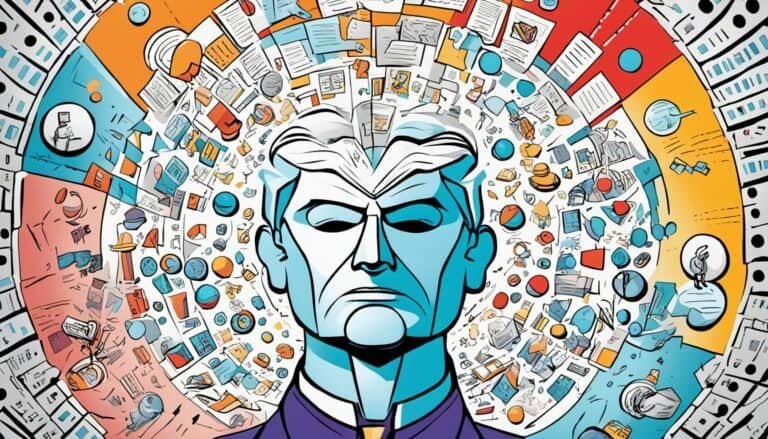Exploring Gardner’s Theory of Multiple Intelligences
Have you ever thought about if IQ tests really cover all types of human smarts? Howard Gardner, a top Harvard psychologist, shook up the idea with his groundbreaking Theory of Multiple Intelligences. He said in 1983 that there’s more to being smart than just IQ scores. He believes we all have many different skills, known as the Eight Intelligences, which help us grow and succeed in our own ways.
This article will look into Gardner’s theory, its background, and what each intelligence means. It will also show how these ideas can be used in schools. By understanding these different kinds of smarts, teachers and students can learn and grow better. This could lead to a future where schools value everyone’s unique talents.
Key Takeaways
- Howard Gardner’s Theory of Multiple Intelligences includes nine distinct intelligences.
- Each individual possesses a unique combination of intelligences that shapes their learning and skill development.
- Gardner promotes diverse teaching methods to align with students’ differing cognitive strengths.
- Critiques of the theory raise questions about empirical support and the clear definition of intelligence.
- The incorporation of multiple intelligences can improve educational outcomes and foster inclusivity.
Introduction to Multiple Intelligences
Howard Gardner introduced the Theory of Multiple Intelligences in the late 1970s. This theory changed how we see intelligence. It says there’s more than one type of smarts, not just what IQ tests measure.
Gardner is a big name at Harvard University. He shared his ideas in “Frames of Mind: The Theory of Multiple Intelligences” in 1983. Since then, he’s written 28 books in 32 languages. He’s known as the leader in the Multiple Intelligences field.
There are eight types of intelligence, like linguistic and spatial-visual. Each person’s mix of these affects how they learn and think. It’s shaped by genes and life events.
Gardner’s ideas help us see the value of personalized learning. Teachers can use different ways to teach, fitting each student’s Learning Style. This approach makes learning more engaging and helps students remember better.
Historical Background of Howard Gardner’s Theory
Howard Gardner was born in Scranton, Pennsylvania, on July 11, 1943. He made big contributions to psychology and education. His work on multiple intelligences came from deep research in cognitive science and human potential.
In 1983, he published Frames of Mind. This book introduced the idea of seven different kinds of intelligences. His work changed how people think about education and intelligence.
Gardner’s ideas pushed educators to see that there’s more to intelligence than just grades. He wrote more books, like Multiple Intelligences: The Theory in Practice and Intelligence Reframed: Multiple Intelligences for the 21st Century. He found eight types of intelligences that show how people are different.
His theory helps us understand how people learn in their own way. It encourages personalized learning and using different subjects together. Gardner’s work has shaped how we teach and assess students today.
The Eight Intelligences Defined
Gardner’s Theory says intelligence is more than just one thing. It’s made up of many different skills we all have. These skills help us shine in various areas of life.
Verbal-Linguistic Intelligence
People with verbal-linguistic intelligence are great with words. They can speak and write well. They often become writers, poets, or public speakers.
Logical-Mathematical Intelligence
Logical-mathematical intelligence is about solving problems and doing math. Those with this skill often work in engineering, math, or computer science. They’re good at logical thinking and solving problems.
Spatial-Visual Intelligence
Spatial-visual intelligence means thinking in three dimensions. People with this skill are good at seeing and moving objects. They often work in architecture, design, or art.
Bodily-Kinesthetic Intelligence
Bodily-kinesthetic intelligence is about using your body to express yourself. These people are great at sports, dancing, or surgery. They can control their movements well.
Musical Intelligence
Musical intelligence is about hearing and making music. Musicians and composers have this skill. They can recognize pitches and create melodies.
Interpersonal Intelligence
Interpersonal intelligence is about getting along with others. People with this skill are good at teaching, counseling, or social work. They understand others well.
Intrapersonal Intelligence
Intrapersonal intelligence is about knowing yourself. Those with this skill often write books, study psychology, or philosophy. They understand their own feelings and thoughts deeply.
Naturalist Intelligence
Naturalist intelligence is about knowing the natural world. People with this skill are great at observing nature. They work in fields like environmental science or biology.
| Type of Intelligence | Description | Potential Careers |
|---|---|---|
| Verbal-Linguistic | Strong language skills | Writer, Poet, Journalist |
| Logical-Mathematical | Analytical problem-solving | Engineer, Scientist, Mathematician |
| Spatial-Visual | Three-dimensional thinking | Architect, Designer, Artist |
| Bodily-Kinesthetic | Physical coordination | Athlete, Dancer, Surgeon |
| Musical | Sensitivity to sound and rhythm | Musician, Composer, Sound Engineer |
| Interpersonal | Understanding others | Teacher, Counselor, Therapist |
| Intrapersonal | Self-awareness | Psychologist, Author, Philosopher |
| Naturalist | Expertise in the natural world | Biologist, Environmental Scientist, Farmer |
Understanding the Eight Intelligences shows how different we all are. By knowing our strengths, we can find the right path in school and work.
Theory of Multiple Intelligences (Gardner): The Ninth Intelligence
Howard Gardner looked into human abilities and found the Ninth Intelligence, called existential intelligence. This type of intelligence means being sensitive to big questions about life, purpose, and death. People with this intelligence dive deep into philosophical and existential thoughts that go beyond daily life.
Existential Intelligence
Existential intelligence is key to understanding us humans. It helps people think about life’s big questions. This makes them better at looking inside themselves and finding meaning.
Gardner’s theory says existential intelligence is a big part of being human. It helps us understand why we do what we do and what we’re searching for in life.
- Connection to personal beliefs: People with high existential intelligence link their beliefs to life’s purpose.
- Influence on creativity: This intelligence boosts creativity, letting people turn their insights into art.
- Guidance in counseling: Counselors use existential intelligence to tackle clients’ deep life questions.
Existential intelligence touches many areas, not just philosophy. In education, it helps teachers guide students through tough topics. It shows us new ways to grow and learn, making life richer for everyone.
| Aspect | Existential Intelligence | Other Multiple Intelligences |
|---|---|---|
| Definition | Sensitivity to deep questions regarding existence | Varied cognitive abilities including linguistic, spatial, and logical skills |
| Application | Philosophical inquiry and personal reflection | Academic subjects and practical skills development |
| Development | Can be nurtured through discussions and philosophical explorations | Can be developed through traditional educational methods and hands-on practice |
Distinction Between Multiple Intelligences and Learning Styles
It’s key to know the difference between Learning Styles and Multiple Intelligences Theory for better teaching. Learning Styles talk about how people like to take in and process information. Tools like the Learning Styles Analysis (LSA) look at these preferences in 49 areas. They show how biology and learning shape our styles.
The Multiple Intelligences Theory by Howard Gardner says there are eight types of smarts, like music and people skills. It shows how people use their smarts in different ways. This theory looks at how we use our smarts to learn.
Learning Styles help us understand how people think and learn. Multiple Intelligences Theory gives a wider view of our smarts. People with similar smarts can learn in different ways, based on their biology and past experiences. Knowing both can help teachers tailor lessons for everyone.
Good teaching and personalized learning can bring these ideas together. Research shows that offering different ways to learn makes learning better. For example, using music, poetry, or art to teach complex topics can reach more students. This approach makes learning more engaging and helps students do well.
| Aspect | Learning Styles | Multiple Intelligences Theory |
|---|---|---|
| Definition | Preferences in information intake and processing | Categories of intellectual capacities |
| Focus | Personal preferences and tendencies | Output function of intelligence |
| Components | Biological and learned elements | Eight distinct types of intelligence |
| Application | Tailored learning experiences | Personalized instructional methods |
| Assessment | Focus on cognitive processing styles | Concentration on intellectual capabilities |
Implications of Gardner’s Theory in Education
Gardner’s Theory of Multiple Intelligences changes how we think about education. It makes teachers rethink old ways, creating lessons that fit everyone’s unique talents. This approach makes schools more welcoming and helps students use their strengths.
Curriculum Development
Creating curricula with multiple intelligences means designing lessons for different skills. This might include art, solving problems, and sports. Such a mix keeps students engaged, no matter how they learn best.
Instructional Strategies
Using Gardner’s theory means teachers can try new ways to teach. They might use group work, hands-on activities, and multimedia. These methods offer many ways to learn and boost creativity and critical thinking in students.
Assessment Techniques
Assessing students with multiple intelligences goes beyond just tests. Teachers can look at portfolios, peer reviews, and how well students perform. This approach helps students see their strengths in many areas, building a positive view of themselves.
| Intelligence Type | Example Activities | Assessment Methods |
|---|---|---|
| Verbal-Linguistic | Storytelling, Debates | Essays, Presentations |
| Logical-Mathematical | Problem-solving Games, Experiments | Quizzes, Projects |
| Spatial-Visual | Drawing, Model Building | Multimedia Projects, Visual Exhibits |
| Bodily-Kinesthetic | Drama, Sports Activities | Performance Reviews, Skill Demonstrations |
| Musical | Songwriting, Playing Instruments | Performances, Composition Assessments |
| Interpersonal | Group Projects, Peer Teaching | Collaboration Assessments, Reflection Journals |
| Intrapersonal | Personal Reflection, Goal Setting | Self-Assessments, Portfolios |
| Naturalist | Gardening, Nature Walks | Field Reports, Observational Studies |
Using Gardner’s Theory in education makes learning richer and more inclusive. It helps us value the many talents in our classrooms.
Applications of the Theory Beyond Education
Gardner’s Theory of Multiple Intelligences goes beyond school. It helps in career counseling, improving organizations, and even in marketing. By seeing the different kinds of smarts in people, we can make work and learning better for everyone.
Career Counseling
Career counselors use this theory to find the best jobs for people. They look at what makes each person smart. For example, someone good at music might do well in music careers. Another might be great at working with people and doing customer service.
Organizational Development
Companies use this theory to make a better workplace. They value the many kinds of smarts in their workers. This way, teams with different skills can come up with new ideas and work better together.
Marketing Strategies
Marketers use the theory to make ads that speak to different people. They think about what each type of intelligence likes. This makes ads more effective and helps brands build loyalty with customers.
Critiques and Support of Gardner’s Theory
Gardner’s Theory of Multiple Intelligences has sparked a lot of debate. Critics say the definitions of intelligence are too broad. They point out that tools to measure these intelligences are not reliable, making their use in schools questionable. Some believe the intelligences Gardner talks about might be talents rather than true cognitive abilities.
Despite the criticism, many teachers support using Multiple Intelligences in the classroom. Research shows that most teacher trainees in the U.S. plan to use these strategies. In Quebec, 94% of teachers use the theory in their teaching. This shows that many believe in teaching to different cognitive strengths.
Recent studies in neuroscience also support Gardner’s ideas. They suggest that the frontal lobe is involved in many cognitive tasks, backing up his theory. However, some argue that we need more proof to fully support the theory.
Teachers like Shearer believe that using Multiple Intelligences makes students more engaged and motivated. Many educators change their teaching to include these ideas, making learning more inclusive.
Even without clear proof, Gardner’s ideas are still being used in teaching. Many think that giving students individualized lessons and using different teaching methods is beneficial. But, it’s important to remember that labeling students by their intelligences might limit their learning.
| Study/Research | Findings |
|---|---|
| Geake (2008) | Frontal lobe governs different forms of cognition. |
| McMahon et al. (2004) | Poor reliability of TIMI; questioning its educational application. |
| Ruhaak and Cook (2018) | 90% of teacher trainees planned to use MI strategies. |
| Blanchette Sarrasin et al. (2019) | 94% of Quebec teachers used MI theory in classrooms. |
| Shearer (2020a) | Educators redesigning curricula inspired by MI theory. |
Conclusion
Howard Gardner’s Theory of Multiple Intelligences changes how we see intelligence. It moves past the old idea of just one kind of smartness. Gardner found eight different kinds of smarts: linguistic, logical-mathematical, spatial, musical, bodily-kinesthetic, interpersonal, intrapersonal, and naturalist.
This theory helps teachers make better lesson plans. It lets them use what each student is good at. This makes learning more effective and fun.
Using Gardner’s Theory also helps in choosing careers and improving organizations. It helps people find jobs that match their skills. This leads to growth in both work and personal life.
Overall, Gardner’s Theory is key to modern education and personal growth. It shows that being smart comes in many forms. This idea helps create learning and work environments that value everyone’s strengths. It has big potential to change education, workplaces, and lives for the better.







